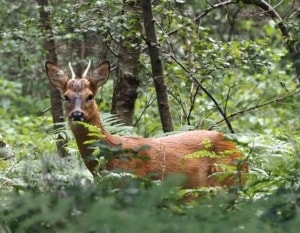October in the Forest

October in the Forest
Most of the deer seen in the Wyre Forest are Fallow Deer. They are a familiar sight in the quieter parts of the forest and at this time of the year the bucks will have moved to their rutting grounds where they will contest their right to mate with a harem of females.
As well as the Fallow Deer there are a growing number of both the exotic Muntjac and the Roe Deer. Even in 2015 Roe were rarely seen in the forest (according to ‘The Nature of Wyre’ by the Wyre Forest Study Group) and it may come as a surprise to hear that they are native to the British Isles, alongside Red Deer. During 2020’s lockdown we frequently saw one lone individual on our walks in the Coldharbour Coppice area of the forest and sightings are gradually becoming more frequent. The buck in Mick Farmer’s photo was seen in Withybed Wood near Buttonoak and I believe they are often in that area. It is very probable that they are now breeding in Wyre rather than wandering in from nearby populations. The 2023 spring census reported sightings of 26 Roe Deer. However, for the first time a drone survey, using thermal imaging, was also carried out and it located 48 Roe, fairly well scattered in groups of up to 4 individuals throughout the forest.
As you can see from the photo, the Roe have a chestnut coat without spots, a big black nose and a white chin. Smaller than the Fallow and larger (and more elegant) than the Muntjac, the bucks have short antlers which are much less extravagantly-branched then those of the Fallow, having up to 3 points. At this time of year they may have shed their antlers, having already mated earlier than the Fallow in July and August. The mated does then delay the implantation of the fertilised eggs and give birth, often to twins or even triplets, in May or June. The kids are spotted with white and must make a very pretty sight.
Deer in general are masters of detection and it is very rare to see them before they see you. Consequently the pale, buff-coloured rump of the Roe may be almost all you see of it as it bounds away from you!
Linda Iles




